
Ronquils is a small family marine ray-finned fish, the Bathymasteridae. These fishes are found only in Arctic and North Pacific waters. This family contains just seven species in three genera. The larger species are important to commercial fisheries as food fish. Ronquils are most closely related to the eelpouts and prowfish in the suborder Zoarcoidei of the order Scorpaeniformes.

Anoplopomatidae, the sablefishes, are a small family of ray-finned fishes classified within the order Perciformes. These fishes are found in the North Pacific Ocean.

Hexagrammidae, the greenlings, is a family of marine ray-finned fishes belonging to the suborder Cottoidei in the order Perciformes. These fishes are found in the North Pacific Ocean.
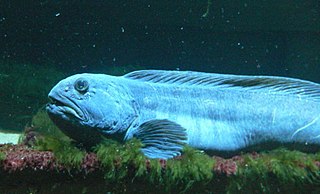
Anarhichadidae, the wolffishes, sea wolves or wolf eels, is a family of marine ray finned fishes belonging to the order Perciformes. These are predatory, eel shaped fishes which are native to the cold waters of the Arctic, North Pacific and North Atlantic Oceans.

Pholidae is a family of marine ray-finned fishes, known as gunnels, in the scorpaeniform suborder Zoarcoidei. These are fishes of the littoral zone and are mainly found in North Pacific Ocean, with two species found in the North Atlantic Ocean and Arctic Ocean.

Stichaeidae, the pricklebacks or shannies, are a family of marine ray-finned fishes in the suborder Zoarcoidei of the order Scorpaeniformes. Most species are found in the North Pacific Ocean with a few in the North Atlantic Ocean.
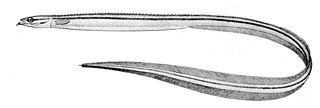
The quillfish,, is a species of marine ray-finned fish, it is the only species in the genus Ptilichthys and family Ptilichthyidae. This fish occurs in the northern North Pacific Ocean.
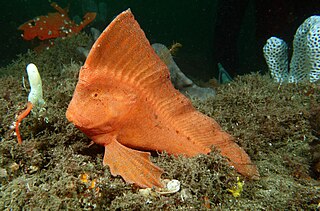
The Australian prowfishes are a small family, the Pataecidae, of ray-finned fishes classified within the order Scorpaeniformes. Australian prowfishes are distinguished by a long dorsal fin that begins far forward on the head, forming a "prow" shape, and extends all the way to the caudal fin. They lack scales and pelvic fins.

Trichodontidae, the sandfishes, is a small family of ray-finned fishes from the order Perciformes. The species in this family are found in the North Pacific Ocean.

Zoarcoidei is a suborder of marine ray-finned fishes belonging to the order Perciformes. The suborder includes the wolffishes, gunnels and eelpouts. The suborder includes about 400 species. These fishes predominantly found in the boreal seas of the northern hemisphere but they have colonised the southern hemisphere.
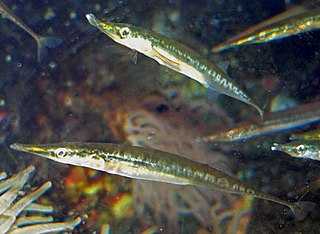
Aulorhynchidae, the tube-snouts, is a small family of marine ray-finned fishes belonging to the suborder Gasterosteoidei in the order Perciformes. These fishes are found in the northern Pacific Ocean.

Pleurogrammus is a genus of ray-finned fishes belonging to the family Hexagrammidae, the greenlings, known as Atka mackerels. These fishes are found in the northwestern Pacific Ocean.

Stichaeinae is a subfamily of marine ray-finned fishes, classified within the family Stichaeidae, the pricklebacks or shannies. These fishes are found in the North Pacific, Arctic and North Atlantic Oceans.
The crisscross prickleback is a species of marine ray-finned fish belonging to the family Stichaeidae, the pricklebacks and shannies. It is the only species in the monotypic genus Plagiogrammus. This fish is found in the eastern Pacific Ocean off California.
Stichaeopsis is a genus of marine ray-finned fishes belonging to the family Stichaeidae, the pricklebacks or shannies. These fishes are found in the western North Pacific Ocean.

The Arctic shanny is a species of marine ray-finned fish belonging to the family Stichaeidae, the pricklebacks and shannies. This species occurs in the North Pacific, Arctic and western North Atlantic Oceans.

Opisthocentrinae is a subfamily of marine ray-finned fishes, classified within the family Stichaeidae, the pricklebacks or shannies. These fishes are found in the North Pacific Ocean.
Lumpenopsis is a genus of marine ray-finned fishes belonging to the family Stichaeidae, the pricklebacks or shannies. These fishes are found in the North Pacific Ocean.
Lycodinae is a subfamily of marine ray-finned fish belonging to the family Zoarcidae, the eelpouts. These eelpouts are found are in all the world's oceans, with a number of species being found off southern South America.
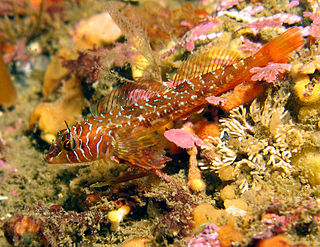
Jordaniidae is a small family of marine ray-finned fishes belonging to the order Perciformes. These fishes are found in the eastern North Pacific Ocean.













